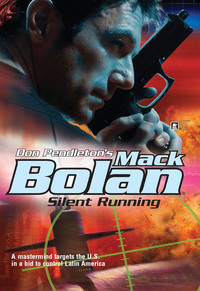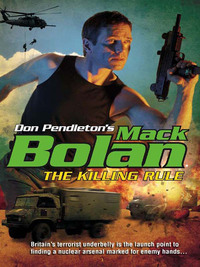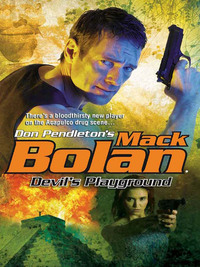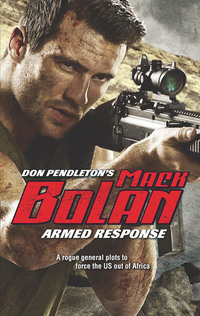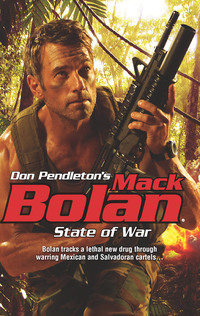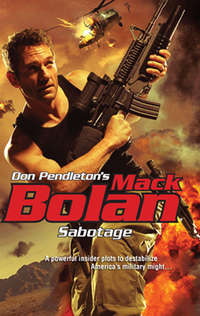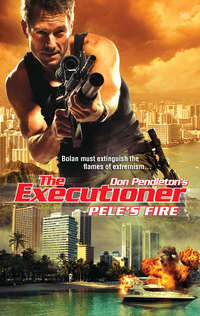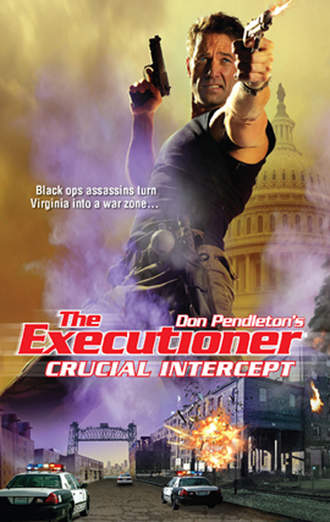
Полная версия
Crucial Intercept
It had only been by the blind luck of the battlefield that he had stumbled across the rolling gun battle in which he was now involved. Whoever these shooters were working for, whatever the connection to Baldero, erasing them and removing them from the combat equation was the one possible option.
Bolan threw himself flat again, lined up on the row of feet on the other side of the van and held the 93-R sideways to aim below and across the big vehicle’s undercarriage. Then he triggered several 3-round bursts.
Two of the men dropped, screaming, their ankles shattered. Bolan put a burst into each one of them, ending their misery. Then he was up again, coming around the front of the van.
The driver was still in position, holding a pistol that looked like a SIG-Sauer. Bolan put a single round through the glass and reloaded on the move, swapping the 20-round magazine for a fresh one from his shoulder harness.
There wasn’t much time. The police would be on the scene before long, responding to what would have to be countless phone calls about the war going on in the middle of the street in this mixed commercial district. His Justice credentials would put him above suspicion, at least eventually, and Brognola could always intervene on his behalf if he got embroiled with the locals, but it would cost time, and time was what he didn’t have. He could hear the combat clock ticking in his head.
He heard the second vehicle moving in from behind him; the throaty roar of the heavy cargo van was unmistakable. There were still shooters from the closer van to deal with, so he focused on those, maneuvering to put this threat between him and the newer group.
Risking a glance around the corner of the near van, he sighted down the driver’s side flank. Two men using the engine block for cover returned fire from where they crouched by the van’s grille. Bolan ducked back just in time, as bullets sparked and ricocheted from the metal of the rear corner of the vehicle.
He considered going for foot shots again, but he dared not place himself prone as the other group moved in from the passenger side. Bolan was already outnumbered and was going to be outflanked, if he was not careful.
The soldier reached into the war bag and found the familiar cylinder of a smoke grenade. The metal was cool to the touch. He drew the canister, popped the ring and let the smoke bomb fly into the midst of the enemy gunners.
The cloud of acrid purple smoke that erupted was a tribute to Kissinger’s skill with ordnance of that type. It immediately enveloped the shooters, obscuring their view of Bolan. They began firing blindly through the smoke. The Executioner hurried, moving to circle their position. As he did so, he drew the Desert Eagle from its hip holster and jacked the hammer back.
The first of the shooters burst from the cloud of smoke, assault rifle blazing. Bolan put him down with a single shot to the head from the big .44 Magnum pistol. The next man came, and the next, but they were blinded by the smoke, shooting wildly, their rounds far off the mark. The Executioner stood his ground and, gun in each hand, shot each man as he cleared the cloud of purple haze.
The gunners weren’t stupid or suicidal. As soon as they figured out what was happening, the parade of half-blinded men stopped.
Then a grenade rolled out of the smoke.
Bolan didn’t pause, didn’t deliberate and didn’t question his instincts. He simply kicked the bomb under the closer van and ran.
The explosion rocked the cargo van, pushing the nose up into the air as if the vehicle were rearing back on its hind axle. Thrown onto his stomach on the asphalt, Bolan felt the sudden wave of heat on his back. The breath was forced from his lungs and he lost his grip on his weapons. The spray of glass, plastic and metal fragments pelted his neck with tiny needles. There was no time to check himself for injuries, though he felt blood trickling down the back of his shirt.
Some sixth sense, some combat instinct—or perhaps just his awareness of the nature of battle—warned the Executioner that death was coming for him. He rolled over onto his back in time to see another man stagger through the last wisps of purple smoke. He had no weapon that Bolan could see. Blood trailed from his ears and his face was burned. He had been too close to the explosion, apparently.
Fixing Bolan with a hateful glare, the wounded man came straight for him. Bolan crabbed backward but had no time to regain his feet. The olive-skinned man landed on him, causing pain to shoot through Bolan’s battered ribs and up his lacerated back.
Fingers wrapped around Bolan’s throat. The weight pressing down on his stomach forced from him what little breath he had managed to regain. Suddenly he was fighting simply to draw air, dark clouds swirling around the edges of his vision.
The man on top of the soldier was screaming in what might have been Farsi. It might also have been simple gibberish; he was clearly mad with pain. Bolan could see burned skin peeling from his attacker’s face as the man roared his fury.
The Executioner’s hand fell to the right front pocket of his blacksuit pants. There, clipped inside his pocket, was a tactical folding knife with a wickedly serrated hawkbill blade. Bolan’s hand clenched around the textured plastic handle of the knife and yanked it free. As he did so, his thumb found the hole cut into the blade. He snapped the folding knife open and heard it lock into place.
The attacker’s eyes widened as the blade flashed into his view. Then he screamed. The Executioner brought the serrated blade down and across the man’s arm, working his way around the arm closer to his strong side. As the grip on his neck loosened, Bolan arched his back, ignoring the pain it caused. He threw the shrieking would-be killer off his chest and rolled over with the man, taking the dominant position.
The attacker was struggling to pull a pistol, apparently forgotten until that moment, from his belt. The Executioner’s knife flashed once across the man’s neck. He died, loudly, and Bolan released the knife, snatching the gun from its position in the dead man’s belt.
Bolan rose to a half-kneeling position, checking his immediate field of vision and also risking a quick glance behind him. His trained, experienced gaze missed nothing—a quick look was all he needed to assess the situation. Then he ejected the magazine in the pistol, checked it and slammed it home again. Press-checking the pistol showed him a 9 mm round in the chamber.
The pistol, which Bolan had first thought to be a SIG, was in reality a PC-9. He needed no reference book to call up what he knew of the handgun. Battlefield experience had made him a walking encyclopedia of firearms data. The weapon was an unlicensed, unauthorized copy of the SIG-Sauer P-226—and it was manufactured in Iran.
His own guns were somewhere on the pavement, but there was no time to look for them. Figures were moving through the pall of black smoke cast by the twisted, burning wreckage of the first van. Bolan detected police sirens in the distance. The clock had run out. He was out of time, his targets slipping that much farther out of his reach, and this fight wasn’t over.
Again employing his gliding, half-crouching fighting gait, the Executioner moved through the smoke to the opposite side of the remaining van. A man holding an assault rifle saw him and drew down on him. Bolan put a single 9 mm round between his eyes.
As he closed on the van and on the shooter’s position, Bolan caught movement from the corner of his eye. He turned in time to intercept a rush of men rounding the passenger side of the van’s grille. He fired quickly in a two-handed grip, first one, then another, and another. The first man fell with a bullet through his brain. The second was clawing at his throat where Bolan’s 9 mm bullet had pierced his neck; the light was already fading from his eyes as he fell to his knees, gurgling and trying to scream. The third man took a slug directly through his heart. He was dead before he finished falling over.
There were still shooters beyond the van, the last of the armed resistance. They fired at Bolan, but the angle was wrong. Both the soldier and his enemies were using the van as the only available cover between them, which meant the gunners had to be content with chewing away from the flanks. Asphalt and paint chips filled the air, ripping past with a noise like tearing cloth, while empty brass littered the street and curb. Those were not the sounds that worried Bolan most.
The police sirens were growing louder; the local authorities would be on the scene in moments. The Executioner did not dare let that happen. Deadly experience, always his guide, told him that the first thing the Farsi-speaking shooters would do, if confronted by police cars, would be to turn their automatic weapons on the law-enforcement officers. Though perhaps well-trained and well-equipped, the cops would not be prepared to roll straight into a barrage of automatic gunfire. Even a S.W.A.T. team would have a hard time coping with so sudden a burst of violence, and the new arrivals were likely road patrol responding to numerous calls of shots fired.
The Executioner had cut a bloody swath through the ranks of the criminal underworld and the international terrorism scene during his endless war for justice. Regardless of the side of the law on which he operated—and he’d spent plenty of time exacting a righteous toll on society’s predators on the “wrong” side of law and government, whenever that had been necessary to get the job done—he had done so while always respecting one rule above all else. He would not take innocent life, and he would not take the life of a law-enforcement officer who was simply doing his or her duty.
Given that, Bolan would no sooner allow those law-enforcement officers to stumble blindly into a killing field that was partly of his own making. It would be like herding cattle through the gates of an abattoir.
Bolan scooped up a fallen assault rifle and snatched two magazines from the belt of the dead man who had wielded the weapon.
The weapon was one he knew, but which he had not encountered often. It was a Khaybar KH 2002, a bullpup weapon based internally on the M-16 A-1 that looked like an ungainly cross between a Steyr AUG and a French FAMAS. He checked the rounds in the magazines by simple eye—this rifle fired the same 5.56 mm round as did the rifles that had inspired its design.
The Executioner took only a second to verify that the weapon was chambered and ready. Then, holding the rifle close to his body, he threw himself prone and rolled across the pavement, his head pointing toward the enemy.
The enemy gunners saw him but had been waiting for a target at waist level. Their fire went high and, before they could compensate, Bolan unleashed a series of tightly controlled bursts from the muzzle of the futuristic-looking rifle.
The 5.56 mm rounds tore through the knot of men, splaying them in every direction. One of them screamed; the others died silently. The screamer managed to clench the pistol grip of a small submachine gun as he left this world. The rounds it discharged caused Bolan to flinch from a fresh spray of sharp asphalt shards that drew blood from his cheek.
The gunfire echoed away at last. Bolan got to his feet, the Khaybar stock tight against his shoulder. He moved quickly and cautiously forward and around the vehicle, checking every direction with fast glances side-to-side and behind him. There was no more movement from among the gunmen. He had killed them all.
The first of the police cars reached him, LED light bars strobing, sirens howling. Immediately, officers threw open their doors and leveled their pistols at Bolan, shouting for him to drop his weapon and make no sudden moves.
The Executioner held the rifle up over his head in both hands. The shouting continued.
“I am an agent of the United States Justice Department,” he said very deliberately, emphasizing each syllable so they could hear him over their sirens. “I have engaged these men to—”
“Shut up!” one of the officers ordered. Two more came up on either side, all of them keeping a prudent distance from the soldier. “Place your weapon very slowly on the pavement!”
Bolan did so. “I am an agent of the United States Justice Department,” he repeated patiently. This was nothing he had not endured before. “I have credentials and identification on my person.”
“Hands behind your head!” the officer shouted again. “Interlace your fingers! Do it now!”
Bolan did as instructed. He was seized, cuffed none too gently and then patted down. The frisk was halted abruptly when the officer realized just how many pouches and pockets the blacksuit had, and how many of these had something lethal in them. His war bag, still slung over his shoulder, was brimming with things that would give an ATF agent apoplexy. Bolan could only imagine how the police would react when they got to that.
“Holy shit,” one of the cops muttered. “This guy is loaded.” He called for the other two officers, the ones who had braced Bolan. The soldier was half pulled, half dragged upright and escorted to a police cruiser. There, his war bag was placed heavily on the trunk as the officer resumed the frisk. The two backup men held their weapons on Bolan the entire time.
The sat phone Bolan carried, which was now on the trunk in a growing pile of his personal weapons and accessories, began to vibrate, skittering across the trunk a few inches as it did so.
That was probably the Farm. Once he spoke to them, word would get passed to Hal Brognola that he would need to intercede, yet again, on Bolan’s behalf. The big Fed had logged far too many hours of his life calming anxious representatives of local law enforcement who did not take kindly to Bolan’s wars waged through their bailiwicks.
Brognola was probably in the middle of having breakfast. Bolan imagined this would ruin his appetite.
3
Bolan sat in the open side doorway of the one intact cargo van, turning the small submachine gun over in one hand. He had his sat phone open and against his ear. Barbara Price’s voice, as sexy as ever to him despite her all-business tone, came clearly across the scrambled link to Stony Man Farm.
“Cowboy verified it based on the photos you snapped and transmitted to us,” Price said. “The weapon is an MPT9K—an Iranian copy of the Heckler & Koch MP-5 K. That makes it a clean sweep, Striker. He says your identifications of the rifle and the pistol you picked up were dead-on.”
The Executioner was not surprised. After a tense half hour during which he had been allowed, on the strength of his Justice credentials, to contact Brognola, who then placed an immediate call back to the police department and local FBI offices, Bolan had been released. The grudging attitude of the officer who had cuffed him hadn’t prevented the man from doing his job in an efficient manner, especially after his own superiors had contacted him and doubly confirmed what Bolan had tried to tell him.
The soldier’s weapons and personal effects had been returned to him, at which point Bolan asserted Justice’s jurisdiction, at least at the outset. The officers had stood back while he used the digital camera in his sat phone to snap pictures of the dead men, their equipment, and the scene of the destruction Bolan had wrought on the street. He had transmitted them to the Farm for analysis.
A crime-scene team had since taken over, scouring the area and tagging and bagging anything that wasn’t nailed down. Once he had his photographs, Bolan had no further need to take charge of the aftermath of the fight. He was content to let the Farm run diplomatic interference behind the scenes. A great deal of covering up of the true nature of the shooters would likely have to be done, if reports of further terrorist shootings were to be averted. Already, several media crews were being kept at bay by uniformed officers wielding collapsible roadblocks and what appeared to be several miles of yellow caution tape.
“I’m done here,” Bolan informed Price.
“We’ll transmit directions to your phone’s GPS application, as usual,” Price said. “I assume you’re headed toward Norfolk.”
“Yes, since that’s the direction our boy was heading when I stumbled into this. You can get the field team moving there, if you haven’t already.”
“They’re well on their way,” Price confirmed. “They’ll beat you there and will act as our advance eyes and ears. Maybe we can yet get you ahead of the Iranians.”
“Iranians?” Bolan asked. “We have confirmation?” While all the weapons the shooters had used were Iranian, and rare enough in the United States, he would not assume the gunmen had been from Iran without some sort of verification. It was one of the oldest “plausible deniability” tricks in the book to equip a team with weapons not traceable to the nation fielding that team, or traceable to a completely different nation, in order to misdirect the enemy and confuse the issue should members of the team be captured or killed.
“That’s affirmative, Striker,” Price said. “We have identities back on half a dozen of your dead men, the ones who have Interpol records. All are Iranian black bag operators. Three were officially dead long before they ever met you. We’ve made some discreet inquiries through the usual channels, but of course the Iranians wouldn’t give us the time of day or a straight answer about this even if we were on good terms with them. It’s pretty obvious that you’re facing an Iranian-sponsored hit team, though what they could want with Baldero is still a mystery.”
“Something’s bothering me, Barb,” Bolan said.
“What is it?”
“It’s no small thing to sneak a small army of commandos into the country. Logic dictates that if you did, you’d equip them locally. Weapons are readily enough come by here, after all, and even illegally obtained automatic weapons would be more easily purchased through stateside contacts than smuggled into the U.S., wouldn’t they?”
“It would depend, Striker,” Price said. “If the Iranians were in a big hurry, they’d equip their team domestically and send them in as quickly as possible, the consequences be damned. It’s not as if we enjoy a good relationship with them.”
“True,” Bolan said. “But if that’s the case, how did they get in? This many men, carrying weapons and explosives? There’s a huge hole in our border somewhere, Barb.”
“That’s not really news, Striker,” Price said, “but I take your meaning. I’ll see if Bear and his people can come up with something. We’ll start prodding other agencies, especially DHS, Coast Guard and Border Patrol to see if we can come up with something.”
“All right,” Bolan said. “I’ve lost enough time already. Time to get moving.”
“Good hunting, Striker.”
“Out,” Bolan said. He closed the phone.
The officer who had first cuffed Bolan, named Sheddon, had been watching the Executioner from out of earshot, giving him time to finish his phone call. When the soldier closed the phone, the cop walked up to him and tried to smile. The result was genuine, if a bit sheepish. Officer Sheddon held up a plastic evidence bag in which Bolan’s bloody folding knife was sealed.
“Agent Cooper?” Sheddon asked, gesturing with the bag. The Justice Department identification that Bolan had flashed liberally to the officers on scene said that his name was “Matt Cooper.” He had worn many aliases in his fight against society’s predators. The exploits of Agent Matt Cooper would be somewhat legendary by themselves, if somebody had the time and the security clearance to start tallying them up.
“Yes, Officer?” Bolan said.
“They’ve cleared me to return your weapons to you, sir,” Sheddon said. He pointed to one of the cruisers. “See Officer Ames, the one with the blond hair, there. He’s got them locked in his trunk, sir. You sure you don’t want medical attention?”
“Thank you, no.” Bolan said. “I assume you have no more questions for me?”
“None that they’ll let me ask, sir,” Sheddon said. He looked irritated and a bit rueful, but he was a good cop and didn’t appear to be holding any serious grudges. “I’m afraid they want the knife, though, sir. Evidence.”
Bolan raised an eyebrow. “Then why not the guns?”
“Plenty of shell casings and bullets to be had.” Sheddon shrugged. “You know how it goes. They don’t want this—” he gestured with the evidence bag again “—walking off if it was used in one of the, er…deaths.”
“I understand. You’re doing your job.”
“Yes, sir.”
“Keep at it.” Bolan nodded to him, stood and offered his hand. Sheddon shook it; his grip was firm.
“Sir?”
“Yes, Officer?” Bolan asked, looking back over his shoulder.
“Good luck with…whatever it is you’re doing.”
“Thank you, Officer.”
It took Bolan only a few minutes to gather up his gear, check the Crown Victoria for damage and get on the road toward Newport News. Once in motion, he pressed the gas pedal as close to the floor as he dared, weaving through traffic with skill and determination. He was already far behind the curve, but there was no point in delaying further. Until he knew otherwise, his quarry was more likely than anywhere else to be in Newport News, Hampton, Norfolk, or beyond it. That meant he needed to be there, too, and soon.
He set the cruise control and, though he knew it was dangerous, spared a glance at his phone. He scrolled through the data the Farm was transmitting to him, calling up each image as it downloaded. There were brief personal biographies of the men for whom identities had been dredged up, and complete dossiers on two men not pictured. Bolan read in fits and starts as he switched his attention from the small screen to the road and back again. These were the Farm’s best guess at the likely leaders of such an Iranian strike group. It was a guess based on past Iranian intelligence ops and what Stony Man’s almost prescient computer team could tell him of known Iranian terror operatives—those operating with the nominal sanction of their frequently rogue state’s government.
The two dossiers were for men named Hassan Ayman, likely the senior member of an Iranian field team assigned to stir up trouble in the United States, and a Marzieh Shirazi, whose name Bolan remembered from several different terror bulletins in Europe. Each man had a file as long as Bolan’s arm. Shirazi was linked to several bombings of targets in Israel, where he had a close working relationship with the PLO and, more recently, with the Palestinian government that incorporated many high-ranking PLO figures, each man among them a murderous terrorist in his own right. Shirazi was small and squat, with a prominent brow, and dark, beady eyes pressed into a face that looked like it had stopped a brick at some point in Shirazi’s teenage years.
Ayman concerned Bolan more. He had no definitive terror incidents or murders assigned to him but, according to the file, he had long been rumored to be an extremely high-ranking official in Iranian intelligence. He was implicated in scores of deaths of civilians and nominally military targets alike, both in Israel and during the Iran-Iraq war. This last started in 1987. Apparently Ayman was believed, by the Farm’s team and as independently theorized by CIA analysts, to have been instrumental in several high-profile atrocities during the tailend of Iran’s “imposed war” with Iraq. If either Ayman or Shirazi was on scene, or if both of them were active in the here and present, on the streets of the urban United States, things would only get more bloody.
The big question remained: what did Iranian black-ops assassins want with a single former CIA cryptographer, a young man who had never, according to his file, worked as a field agent or on anything resembling a project related to Iran? This much was included in the data the Farm had sent on Baldero. It was a puzzle, and Bolan did not like puzzles. They pointed to incomplete information, and incomplete information, though a common problem in the field, was the most frequent cause of lost engagements. To gain and keep the initiative in combat required that he surprise his enemies. He did not intend to be on the other end of the exchange.


